| Srl | Item |
| 1 |
ID:
053657
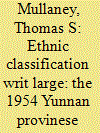

|
|
|
| 2 |
ID:
147649
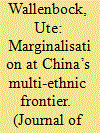

|
|
|
|
|
| Summary/Abstract |
China consists of a mosaic of many territorial ethnic groups whose historic homelands have been incorporated into the modern Chinese state, a process by which the respective populations transformed from a “sovereign or semi-sovereign people” (Bulag 2002: 9) on China’s periphery into “minority nationalities” (少数民族, shaoshu minzu). In 1950 Mao Zedong initiated the “Ethnic Classification Project” whose effect has been the marginalisation of the minority nationalities. In this paper, I explore the marginalisation of the Mongol population of contemporary Henan Mongolian Autonomous County within the Huangnan Tibetan Autonomous Prefecture in southeastern Qinghai Province. By seeking to understand how Henan Mongols deal with their socio-political and demographic marginal status, the aim of this article is to shed light on how they utilise their marginal position, and how they centralise themselves as an independent party interacting with the civilising missions of China and Tibet.
|
|
|
|
|
|
|
|
|
|
|
|
|
|
|
|
| 3 |
ID:
141161
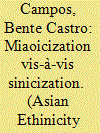

|
|
|
|
|
| Summary/Abstract |
This article studies the Miao classification as an example to examine the minzu shibie project initiated by the Chinese Communist Party after 1949. The Miao classification that originates with the minzu shibie project can be defined as a process of miaoicization; however, it is not a unified Miao group (as projected by the classification team) that has emerged but rather one dominant Miao subgroup that defines the official Miao category in contemporary China. At the moment the most dominant Miao subgroup is the Hmu group in Southeast Guizhou. The overemphasis of Hmu sub-culture to represent all the Miao of China is related to the fact that over the last decades many important leaders in Guizhou have been Hmu. While all Hmu are sinicized to a certain extent, it seems that the Hmu at the bottom of the socioeconomic scale are most likely to be sinicized and to amalgamate with the Han majority.
|
|
|
|
|
|
|
|
|
|
|
|
|
|
|
|
| 4 |
ID:
184075
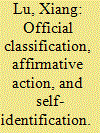

|
|
|
|
|
| Summary/Abstract |
The existing literature on the self-identity of multiethnic people focuses on Western countries where mixed identities have been normalised in census-taking. It remains unknown how multiethnic people identify themselves in countries where ethnic classification is exclusive and rigid and ethnicity is a mainly ascriptive legal category. Based on in-depth interviews with twenty Hui-Han biethnic college students in China, this article shows how official ethnic classification and affirmative action shape these people’s self-identification. Most respondents identify themselves as Hui regardless of their cultural practices, as their parents registered their official ethnicity as Hui and they have internalised this identity. The multiethnic background is more frustrating for students at China’s special ‘universities for ethnicities’ because ethnicity is a salient topic on campus and they experience more expectations to behave like Hui. Many respondents have an essentialist understanding of ethnicity and express unsupportive attitudes towards institutionalising mixed identities.
|
|
|
|
|
|
|
|
|
|
|
|
|
|
|
|
| 5 |
ID:
099701
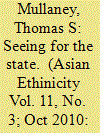

|
|
|
|
|
| Publication |
2010.
|
| Summary/Abstract |
This article proposes a new understanding of the Ethnic Classification project (minzu shibie) undertaken in China's southwesternmost province of Yunnan in 1954 - a project in which social scientists and Communist Party cadres set out to determine which of the dozens, if not hundreds, of minority communities in the province would be officially recognized by the state. Specifically, this article argues that ethnologists and linguists played a far greater role in the Classification and early Chinese Communist governmentality than is typically assumed. The Chinese Communists did not teach themselves how to 'see like a state,' to use James Scott's formulation, at least not when it came to the fundamentally important problem of ethnic categorization. To the contrary, the history of the Classification project is one of an inexperienced Chinese state that was able to orient itself only by observing the world through the eyes of its social scientific advisors. The 'mentality' within early Chinese Communist Party (CCP) 'governmentality' was, in the case of the 1954 Ethnic Classification, in large part the mentality of the comparative social sciences.
|
|
|
|
|
|
|
|
|
|
|
|
|
|
|
|
| 6 |
ID:
145851
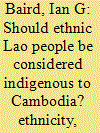

|
|
|
|
|
| Summary/Abstract |
The ethnic Lao are not well-known in Cambodia, despite constituting a substantial but unrecorded population there. Even though the Lao have lived in Cambodia for many generations, they were excluded from being considered ‘indigenous peoples’ when the category was legally introduced to Cambodia through the 2001 land law. Instead, they are not classified as ‘ethnic Lao’, except for the very few who were actually born in Laos. Here, I consider how the politics of identity in Cambodia has separated some highland ethnic minorities from the Lao. Many ethnic Lao in Cambodia quietly disagree with not being classified as indigenous. This contestation represents a similar dynamic to the differences of opinion between the Asian Indigenous Peoples Pact (AIPP) and the peasant organization, La Via Campesina, regarding advocating for indigenous and peasant rights, respectively. My objective is to demonstrate that the politics of indigenous categorization in Cambodia is complicated and fraught.
|
|
|
|
|
|
|
|
|
|
|
|
|
|
|
|